As the popularity of non-fungible tokens (NFTs) continues to rise, many people are curious about the way scarcity and rarity influence the value of these digital collectibles. Given the keyphrase “how much to make an NFT,” it’s important to understand how the factors like scarcity, uniqueness, and demand play a vital role in determining an NFT’s price. In this article, let’s explore the intricate relationship between NFT prices and their scarce nature.

Understanding Scarcity and Rarity in NFTs
To comprehend the relationship between NFT prices and scarcity, it is essential to first get a grasp of the distinction between scarcity and rarity in the world of NFTs. In this context, scarcity refers to the limited number of available NFTs in a specific collection, whereas rarity describes the uniqueness of the characteristics or the attributes that differentiate one token from the others.
Both of these factors can have a considerable effect on NFT prices; however, it is the intersection between scarcity and rarity that often leads to higher valuations. When an NFT is both scarce and rare, it may garner more attention in the market, driving up bids and boosting its value.
The importance of scarcity in determining NFT price
An NFT’s scarcity can be a primary factor in driving up its value. When there are limited editions of a particular item or series, it increases their demand due to the exclusivity they offer. Collectors may be more willing to pay a higher price for NFTs they perceive as scarce. A great example of this concept in action is the popularity and pricing of CryptoPunks, a collection of 10,000 unique pixelated characters, where no more will be created, making them a scarce commodity.
Scarcity can also come into play in the form of limited time sales or minting events, resulting in a surge of interest and potentially increasing the token’s worth. However, it is crucial to note that scarcity alone might not automatically translate to high value. The perceived utility, artistic value, and the profile of the creators also factor into an NFT’s overall worth.
How rarity affects NFT pricing
While scarcity might limit the number of NFTs available, it is the rarity of an NFT’s traits or characteristics that can further contribute to significant value growth. Unique attributes, like special artwork, exceptional utility in a virtual setting, or an exclusive in-game asset, make certain NFTs more desirable to collectors and investors.
For example, the Bored Ape Yacht Club (BAYC) collection features various combinations of traits, distinguishing one ape from another. Apes with rare traits can command a much higher value compared to more commonly found traits. Rarity also applies to the history or provenance of the NFT, such as ownership by a notable figure. For instance, NFT art acquired by prominent collectors or celebrities can significantly increase the NFT’s perceived rarity, and thereby, the value.
Demand and market sentiment

While scarcity and rarity are crucial factors in determining NFT prices, ultimately, it is the demand and market sentiment that seals the fate of an NFT’s valuation. The willingness of collectors and investors to pay a certain price shapes the prevailing market rate. NFTs associated with popular creators, brands, and projects typically have higher perceived value and a more robust market demand.
Additionally, market sentiment, driven by the overall outlook on the NFT market, trends, and investor enthusiasm, also play a part in determining an NFT’s price. Periods of frenzy or hype can inflate prices, while negative sentiment and a lack of interest can cause values to plummet.
Wrapping Up

In conclusion, the relationship between NFT prices and scarcity is multifaceted and often interwoven with factors like rarity, demand, the profile of the creators, utility, and market sentiment. Scarcity and rarity can contribute to higher valuations, but the ultimate determiner is the intersection of these factors in the minds of collectors and investors when they appraise an NFT’s worth. It’s essential to remember that pricing is influenced by sentiment and hype, highlighting the need to remain informed and discerning when navigating the world of NFTs.
